Adam Yamey's Blog: YAMEY, page 6
August 12, 2025
A church left abandoned in a field in Oxfordshire
NOT FAR FROM Henley-on-Thames, lies the village of Bix. Its name might derive from either the Anglo-Saxon word for box, an evergreen shrub, or from a word, ‘behaeson’ meaning ‘to vow’. By 1085, when the Domesday Book was compiled, Bix was divided into two nearby settlements, each of which had its own church. One of these has disappeared, and the other, St James, is now in ruins.
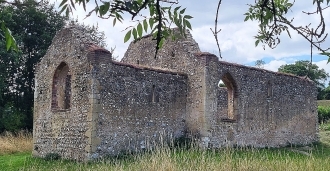
Still consecrated but in a dilapidated state, St James is now known as Bix Old Church. Very little is known about the early history of this ruined church. It was in existence by 1274, when it and the other church were so poor that they had to share a vicar. In the late 1700s, the walls of St James began to collapse. So, brick buttresses were constructed to prevent further damage. These buttresses are still standing, but they failed to halt the collapse of the church. In 1874, the church was deemed unusable, and a new church, the present St James, was built.
We visited the new church, arriving just in time to meet someone who was about to unlock it. Constructed in 1874, it is a Victorian gothic edifice. Inside, the church is built with bricks of differing colours arranged in layers to produce an eye-catching appearance. What makes this church fascinating is that it contains various things that were rescued from Bix Old Church: the font; two fragments of Flemish stained glass dating from 1530; and the carved stone bowl of the piscina. These valuable remains were moved from the old church to the newer one in 1875.
Bix Old Church is reached by a long country lane that is only wide enough for one car. It and the church are in surprisingly a rural environment, considering how close it is to places like Henley, Reading and High Wycombe. We visited the church mainly because when I passed a sign for Bix, which I thought was a strange name, I looked it up on the Internet later while enjoying a picnic, and found out about the existence of the ruined church. Once again, a short visit into the English countryside has resulted in an unexpected, fascinating discovery.
August 11, 2025
A library that is far from mundane in north London
VISITORS TO LONDON (and residents of the city) should not miss visiting Kenwood House, which is in north London between Hampstead and Highgate. Not only does it contain a magnificent collection of Old Master paintings that can be compared favourably with what can be seen in Britain’s finest public art galleries, but it also has a beautiful library.
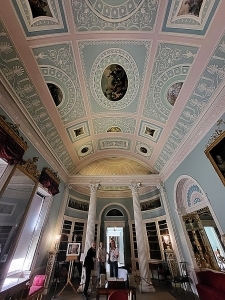
In my book about Hampstead, “Beneath a Wide Sky: Hampstead and its Environs”, I wrote:
“The first house to stand on the site of the present one was built in brick by John Bill (1576-1630), printer to King James I. He bought the Kenwood Estate (which was known as ‘Caen Wood’) in 1616. After several changes in ownership, the Estate was bought in about 1747 by a former Prime Minister and King George III’s close associate, John Stuart, third Earl of Bute (1713-1792). In 1754, Bute sold the property to the lawyer and law-reformer William Murray (1705-1793), who became the First Earl of Mansfield, and was Lord Chief Justice of the King’s Bench from 1756 to 1788. In 1778, he was a supporter of the Roman Catholic Relief Bill that led to the violent protests described above. During the First Earl’s stay in the House, he employed the architect Robert Adam (1728-1792) to make improvements.”
The library was one of the improvements that Robert Adam created at Kenwood. The library or Great Room was constructed between 1764 and 1774. It was intended both as a reception room and a library, which might explain why so little of this large room’s wall space is occupied by bookshelves. Most of the wall space is occupied by mirrors and windows. Lord Mansfield would have been used to host guests, hold dinners, and for music performances.
The library’s architecture is based on that of Roman public bath houses. John Summerson (1904-1992), the architectural historian, wrote of its design in his “The Iveagh Bequest, Kenwood : a short account of its history and architecture” (published 1988):
“This is one of the finest Adam rooms in existence … The shape of the room, with its curved ceiling leading into two apsidal ends, on the chords of which are pairs of columns, is one which Adam used for several of his most stately interiors. Apart from the plan, a great innovation for England was the flat arched ceiling which Adam frankly describes as ‘extremely beautiful …”
Although the library is the finest of Adam’s creations at Kenwood, there are others that deserve to be admired. These include the orangery, the entrance hall with its magnificent stucco ceiling, and the library’s anteroom. In this piece I have concentrated on the interior of Kenwood House, but a visit to this wonderful place should be accompanied by a stroll in the place’s superb, landscaped gardens.
August 10, 2025
Painted on a wall in Peckham
August 9, 2025
Portraying American women who married British nobility
WHEN A FRIEND invited us to join him at London’s Kenwood House to view an exhibition of portraits by the artist John Singer Sargent (1856-1925), I had some misgivings. In the not-too-distant past I saw an exhibition of his portraits at the Tate Britain, and I left it unimpressed. In that show, the portraits were displayed alongside the dresses that the sitters had worn for their pictures. In contrast, the show, which is on at Kenwood until 5 October 2025, was very satisfying.
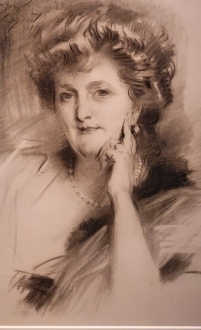
Between 1870 and 1914, 102 American women married men in the British peerage, and more than this married into the British upper class. Put bluntly, the men were enriched by their American brides’ money, and the ladies acquired social positions that were highly regarded in British society. Regarding these marriages, Theodore Rooseveldt said:
“I thoroughly dislike … these international marriages … which are not even matches of esteem and liking, but which are based upon the sale of the girl for her money and the purchase of the man for his title.”
Sargent, the artist, made portraits of more than thirty of these brides, and it is a selection of these that are on display at Kenwood in an exhibition appropriately named “Heiress. Sargent’s American Portraits”. Each picture is accompanied by an information panel that gives interesting biographical details about the ladies.
Undoubtedly, Sargent’s grand portraits made with oil paints on canvas are superb. However, even better than these, and there are several on display at Kenwood, are his charcoal sketches. Unlike the paintings that required the subject to attend 6 or more sittings, the charcoal portraits were completed in one sitting. Despite or maybe because of the rapidity of completing the charcoal images, these portraits seem to be even more expressive than the oil paintings upon which he had spent far more time. During a period of 20 years, he completed almost 700 charcoal portraits. Although there might have been one or two of his charcoal portraits at the Tate exhibition, a great proportion of the exhibits at Kenwood were examples of Sargent’s superb charcoal technique. For me, the highlights of this small exhibition were the works executed in charcoal.
I left the show at Kenwood feeling pleased that I had been, and with a greater appreciation of Sargent’s talent than I had before.
August 8, 2025
Alien Shores in south London’s Bermondsey
THE ARTIST ANSELM Kiefer is said to have remarked:
“I think there is no innocent landscape, that doesn’t exist.”
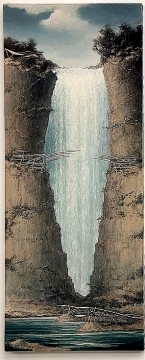 By Nomoru Minata
By Nomoru MinataFor what we see when we regard a landscape is the result of millions of years of geological and meteorological evolution as well many millennia of interventions by biological phenomena including human activities: both constructive and destructive. As the writer and academic Robert Macfarlane wrote:
“We live on a restless crust of earth. Behind the façade of stability, everything is shifting, imperceptibly, but continuously.”
Artists have been creating images of landscape for many centuries. The earliest known depictions of landscape include Minoan frescoes created in about 1500 BC. The genre of European art called ‘landscape painting’ began in Holland in the seventeenth century. The website of the White Cube Gallery in Bermondsey noted in connection with this:
“17th-century Dutch artists of the Golden Age, during which the genre ‘landschap’ was first named, turned away from religious subjects as an expression of Protestant values …”
Until 7 September 2025, the White Cube at Bermondsey is hosting an exhibition called “Alien Shores”. Curated by Susanna Greeves, this show:
“… explores landscape as a place of memory, imagination, yearning and belonging. Through painting, video, photography and sculpture, the artists included offer speculative, symbolic or surreal depictions of emotional terrain and voyages of the imagination, visions of the distant past or possible futures.”
The exhibition includes works by 37 artists, all of whom worked in the twentieth and/or twenty-first centuries. It is a display of modern and contemporary works of art that either depict landscapes or try to evoke thoughts of landscapes. The works are distributed amongst three rooms. In the first two rooms there are videos and kinetic sculptures as well as paintings. A video by Noémie Goudal is particularly fascinating and dramatic. The third and largest room contains a mixed bag of paintings and a sculpture by Noguchi. My enjoyment of the paintings in this room was not 100%. Some of the paintings looked like wall space fillers rather than great works of art. However, it his is not a room to be missed because it contains three outstanding landscapes by Anselm Kiefer. Seeing these in the company of many of the others served to emphasize (to me) what a great contemporary artist he is. Other ‘stars’ in this room were paintings by Minoru Nomata, Georgia O’Keeffe and Marina Rheingantz. A three-dimensional screen depicting a leafless forest by Eva Jospin in the long corridor of the White Cube also impressed me.
Although I wondered why a few of the artworks were included in the show, the Alien Shores exhibition has much to recommend it. It was fascinating to see how in a time frame of well under 100 years, artists have been tackling their various portrayals of landscape, and the interesting varieties of ways they have done it.
August 7, 2025
Trekkers beyond the age of 65 should be discouraged
WHILE SORTING SOME old papers, we came across a permit issued to us in Kolkata (Calcutta) in November 2019. It is a document that allowed us to visit Sikkim for five days.

Sikkim, which is a mountainous territory is near to China, in northeast India was an independent kingdom until April 1975 when the king was deposed and its people chose by referendum to become part of India. It is now one of the states of India. Foreigners can visit Sikkim but only after they have obtained a permit. We acquired ours without difficulty in central Kolkata. The wording on the permit lists the places which its foreign holder(s) can visit. The rest of Sikkim is out of bounds.
What I only noticed after finding this permit recently (in August 2025) is that it bears some words of advice:
“Trekker(s) beyond the age of 65 should be discouraged”
From what, it does not say.
August 6, 2025
Down the slope to an uncertain fate in France and Flanders
A PARABOLIC ARCHWAY made of stainless-steel straddles a pedestrianised roadway on the clifftop near to the harbour in Folkestone (Kent). A few yards east of the archway, the road descends steeply towards the harbour and a pier from which ships used to sail to and from Fance. The impressive metal hoop was inaugurated in 2014 by Prince ‘Harry’, son of King Charles III. It commemorates the one hundredth anniversary of the start of WW1. The roadway that runs along the clifftop and then down to the harbour is now known as Road of Remembrance. On a fence close to the archway, there are thousands of crocheted poppies, lovingly made by women mourning the tragedy of the so-called Great war.
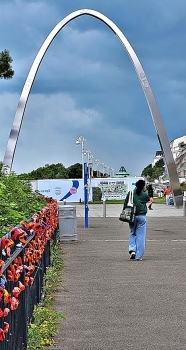
It was along this road and down the slope, formerly known as Slope Road, that during the Great War (1914-1918) millions of soldiers and auxiliary staff marched from nearby Shorncliffe Camp to the harbour, where they embarked on ships that carried them across the English Channel to war-torn France. As a BBC website page (www.bbc.co.uk/news/uk-england-22892729) related in connection with the roadway:
“For many of the millions of servicemen making their way to the trenches of World War I it was the last part of Britain they stepped foot on.”
The archway, which is close to the steep slope is called the Step Short Memorial Arch because as the website explained, “Step Short” was:
“… the order given to the marching men to shorten their stride as they went downhill.”
When we visited Folkestone in July 2025, we were able to walk beneath the arch, see the poppies, and read the various emotional commemorative information panels near it. However, the sloping part of the road leading down to the harbour was closed off for repairs. The banks lining the slope had begun to subside making it hazardous to be on this historic stretch of road.
I was very much moved by the Road of Remembrance, the archway, and the various memorials. For many of those who marched down that steep slope, it would be the last time they would ever see England. For, as is recounted in a British Parliamentary website (www.parliament.uk/business/publicatio...), during WW1:
“… 880,000 British forces died, 6% of the adult male population and 12.5% of those serving.”
That means that about one out of every eight men walking along where the arch now stands and then down the slope would die across the Channel in France or Flanders.
The pointlessness of war.
August 5, 2025
An Englishman’s home is his castle
IN 1604 THE COURT of the KIng’s Bench made a judgement in the case of Peter Semayne v Richard Gresham. It was a trial during which Peter Semayne was suing his tenant Richard Gresham for an outstanding debt. The Court found against Semayne on several counts, one of which was: “It is not a felony for a man to defend his house to the death.” In 1605, the lawyer and politician Edward Coke (1552-1634) summarised the case in the fifth volume of his “Reports”. Amongst his conclusions about this case, he wrote:
“… the house of every one is to him as his castle and fortress, as well for his defence against injury and violence, as for his repose …”
And by the eighteenth century, the words “An Englishman’s home is his castle” had come to encapsulate what had been decided in law during the trial mentioned above.
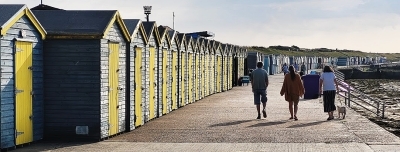
Visitors to the British seaside cannot miss seeing rows of single storey beach huts close to the beach. Holidaymakers and local inhabitants hire or purchase these tiny huts to store their deckchairs; bathing equipment; simple cooking equipment; and other items to make spending a day at the beach enjoyable. Each hut is its owner’s or tenant’s small dwelling by the beach. However, as we learned during a visit to Minnis Bay in Kent, nobody can spend the night in a beach hut. They have to be vacated and locked up at the end of the day. Seeing people using these small structures, I felt that they regarded their huts as extensions of their homes, but unlike their actual dwellings, these temporary homes cannot be regarded as their castles.
August 4, 2025
The Sunken Boat and the sea at the Turner in Margate (Kent)
I HAD NEVER HEARD of the artist Anna Boghiguian (born 1946) until we visited her exhibition at the Turner Contemporary Gallery in Margate (Kent). Anna was born in Cairo (Egypt), where she studied political and social sciences at The American University. She also studied fine arts and music at Concordia University in Montreal (Canada). The works on display at Margate until 26 October 2025 are a superb synthesis of both her interests in world affairs and artistic talents.
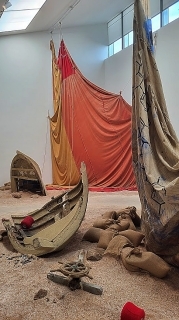
Anna’s show at the Turner is called “The Sunken Boat: A glimpse into past histories”. It consists of three installations, one in each of three spacious galleries. One gallery contains an installation comprising a set of sandy beaches littered with the remains of wrecked boats and sails along with other flotsam and jetsam. The walls of the room have frames containing images relating to historical and ecological events. Regarding this fascinating and beautifully composed exhibit, the gallery’s website noted that the installation:
“… the centrality of the sea in shaping histories of labour, trade, ecological collapse, and political conflict. It combines sculpture, painting, cut-out figures and sound, inviting reflection on rising sea levels and geopolitical tensions around undersea communication cables.”
Another room has a cluster of cut-outs depicting famous people of the past including Einstein, Gandhi, Queen Victoria, Napoleon, Pythagoras, and many others. Each of the cut-outs are colourfully painted and are suspended from the ceiling by fine threads, and hang above a large black and white chess board. They rotate gently in reaction to movements of the air caused by motions of the viewers.
The third gallery contained an installation that evoked being under the sea. Figures either swimming or drowning are suspended from the high ceiling. The room is lit with a blueish glow that gives the viewer the feeling of being below the sea’s surface. The floor of the gallery is a representation of the seabed, with undersea cables, marine creatures and plants, assorted debris, and other objects one might expect to find there. The lighting was chosen to evoke the reduced illumination that one can imagine exists deep below the sea’s surface. It reminded me a little of the church at Tudely (Kent) whose stained-glass windows by Chagall create the same impression. In this church, Chagall designed the windows to create the impression of being below the sea because the edifice is dedicated to the memory of someone who died by drowning. Unlike the church at Tudely, the installation at the Turner expresses a less specific, more global concern: that of the sea’s ecology at present and in the future.
Words can hardly do justice to the amazing show at Margate. Without doubt, it must be seen to be fully appreciated. The exhibition illustrates that Anna Boghiguian is a competent and imaginative artist with a great grasp of past and contemporary political and present ecological challenges facing the waters in our seas and oceans. And she knows how to express these matters in imaginative and compelling ways,
August 3, 2025
The cock and lion
THERE IS A PUB in London’s West End called “The Cock and Lion”. It is located in Wigmore Street and was established in 1786. Its sign is a large golden lion with a tiny golden cock standing on its back. I wonder what this signifies.
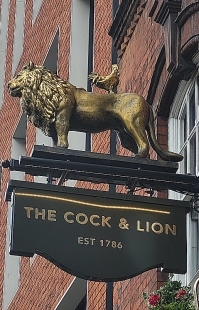
Is the lion Great Britain and the cock France? If this is the case, why is the emblem of the once traditional enemy and rival of England perched on the back of an emblem of Britain? Does anyone know the meaning of this combination of bird and beast?




